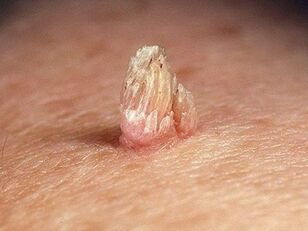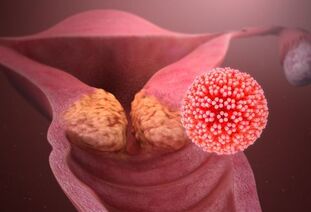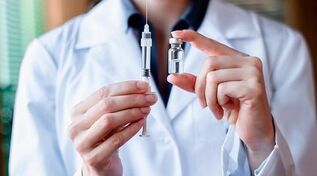
Human papillomavirus (HPV) is a grouped name for DNA viruses that spread from person to person and trigger benign tumors - papillomas. Some varieties are oncogenic (i. e. , increase the risk of malignancies). HPV is most commonly associated with cervical cancer, which kills thousands of women each year. However, these viruses also affect the development of other cancers: not only in women but also in men.
HPV does not appear as a symptom for a long time: patients often only find out if they have pre-cancerous conditions or cancer. HPV is a threat to patients of all genders and ages, including young children. Nevertheless, its main "target audience" is people aged 15-30: they are sexually active, do not always think about precautions, and in most cases HPV is sexually transmitted.
To prevent the virus from reaching the body to such an extent, it is recommended that you check your health regularly to rule out any pathologies it may cause. There are also tests for HPV to detect the presence of oncogenic strains. Take care of your health right now: make an appointment at the Otradnoe Polyclinic and go to a medical consultation without having to wait in line or adjust to an inconvenient time for you
What is HPV
Human papillomaviruses, which enter the body through skin microtraumas, enter the cells of the basal layer of the epithelium. HPV can exist in any layer of the epidermis. However, it reproduces exclusively in the base layer.
The virus develops in two stages:
- Reproductive - the virus enters the cell without affecting its chromosomes and multiplies.
- Integrative - HPV enters the genome of an infected cell.
The virus transforms cells in the second stage. They begin to actively divide and tumor-like formations - papillomas - appear. These are prominent papillary growths on the surface of the skin (hence the name: papilloma - the Latin papilla - nipple and Greek oma - tumor). The second stage does not always occur. The virus, being in the first stage of development, is able to regress (leave the body). Even if the patient has no abnormalities, it is a carrier of HPV and is able to infect other people.
The incubation period can range from 3 weeks to one year. On average 3 months. In some cases, non-genital forms of papillomas first appear and then neoplasms appear on the genitals.

In most cases, the body will cope with the virus within 2 years. However, re-infection can also occur - with the same or a different strain. In addition, papillomas or other skin manifestations are able to regress after 6-8 months (gradually decreasing and later disappearing). This happens when the immune system suppresses the virus and "survives" the cells.
The HPV virus most commonly affects the skin and mucous membranes:
- Anogenital area.
- Upper respiratory tract.
- Oral cavity.
- Bronchus.
- Conjunctiva.
- Rectum.
- Esophagus.
HPV types
The first human papilloma virus (HPV) was isolated in 1971. And scientist Harald zur Hausen was able to identify and prove the link between HPV and cervical cancer. He then received a Nobel Prize for his discoveries.
About 600 different HPV strains are currently known. Some provoke the appearance of warts, others - genital warts and others - papillomas. Among HPV, there are types that affect the development of cancerous tumors. They are called oncogenes. Fortunately, there are not many of them. They have low, medium or high oncogenic potential:
- Strains 6, 11, 40, 42, 43, 44, 54, 61, 70, 72, 81 are characterized by low oncogenicity.
- Mean oncogenicity in types 26, 31, 33, 35, 51, 52, 53, 58, 66.
- High oncogenic potential in strains 16, 18, 39, 45, 56, 59, 68, 73, 82.
Cervical cancer is most commonly caused by types 16 and 18.
Help!The presence of an oncogenic HPV type in the body does not mean that a person is "doomed" to cancer. The presence of the virus increases the risk of developing cancer, but this is not the only reason for their occurrence.If a patient has an oncogenic HPV strain, they should only monitor their health closely and undergo regular preventive examinations. If necessary, your doctor will prescribe appropriate therapy for you.
The reproductive system of women and men can infect about 40 types of papillomavirus. The result of their activity is not only cancer, but also genital warts or warts.
Help!Cancers develop slowly: within 5-30 years after papillomavirus infection. They are preceded by pre-cancerous conditions (benign tumors that can progress to malignancy). That is why it is so important to have regular preventive tests. Cancer prevention conditions, and even the initial stage of cancer, can be treated perfectly and dangerous consequences avoided.
HPV transmission pathways
The main "condition" of the infection is micro-damage to the skin or mucous membranes (wounds, cracks, scratches). They are the “gates” of HPV.
The most common way the virus spreads is when two people come in contact with their skin or mucous membranes. Therefore, the main route of papillomaviruses is sexual contact. Moreover, the use of a condom does not rule out the possibility of infection. The virus can be spread through oral sex, which does not always use contraception. In addition, condoms do not cover the entire surface of the penis and are often placed in the middle of sexual intercourse. You can also get HPV by kissing.
HPV can also be transmitted:
- From mother to child as the baby passes through the birth canal.
- At home: when using other people's hygiene products (towels, toothbrushes, shaving accessories).
- In public places: saunas, gyms, swimming pools.
Help!The survival time of papillomaviruses in the external environment is short. Therefore, the risk of home infection, although present, is much lower than in the case of sexual contact.
Self-infection is also possible: the virus is transferred from one part of the body to another during hair removal, skin combing, nail biting.
Contact with a virus does not always occur. The following factors increase the risk:
- Decreased immunity.
- Bad habits: smoking, drinking.
- Stress.
- Sexually transmitted infections.
- Diseases of the urinary system.
- Damage to the skin and mucous membranes.
- Immune deficient conditions.
- Long-term use of hormonal contraceptives.
Help!Oncogenic HPV strains are more dangerous to women than men because they become more common with them.
HPV: Symptoms
Papillomaviruses have no symptoms for a long time. Usually, the patient becomes aware of the presence of HPV as the consequences develop: warts, papillomas, genital warts. In some cases, the following signs may indicate the presence of a virus:
- Redness, skin growth (most commonly in the genital area);
- Itching.
- Pain and other discomfort during or after intercourse.
What diseases can HPV cause?
Papillomaviruses primarily cause an increase in papillomas, warts, and genital warts in patients of both sexes. All of the above tumors can occur in any part of the body. Most often, however, they affect the genitals and anal area. In women, they occur in the vulva, cervix, and vagina. In men - the scrotum, the head of the penis, the foreskin. In patients of both sexes, tumors often appear in the anus.
Warts often appear on the soles of the feet, larynx, and vocal cords. Papillomas (flesh-colored papillomas) do not have a “favorite place” - they can appear on the trunk, neck, face, arms and legs. Flat warts are most common in children and adolescents (they are also called youthful or juvenile). These are small (3-5 mm) dark tumors that protrude slightly above the skin surface. They most commonly occur on the hands, face, and back of the legs.

When it comes to cancer, most patients are associated with HPV, primarily cervical cancer. Indeed, this pathology is very common nowadays. However, HPV often provokes the development of vaginal and vulvar cancer in women (65-70% of cases) and penile cancer in men (50% of cases). Papillomaviruses can contribute to the incidence of malignancies in both women and men:
- rectum;
- oral cavity;
- larynx.
In children, HPV usually manifests as an increase in papillomas due to a decrease in immunity due to previous diseases, usually viral or bacterial infections. Papillomaviruses also infect young patients with allergic reactions or frequent colds.
HPV and pregnancy
Papillomaviruses negatively affect female fertility. If present, the likelihood of pregnancy is halved, as HPV can interfere with fertilized egg implantation. If the partner is also infected with the virus (this occurs in 65-70% of cases), the chances of conception are further reduced. HPV negatively affects sperm motility.
Papillomavirus increases the risk of developing pregnancy:
- Small or polyhydramnios.
- Chronic placental insufficiency.
- HPV can also cause miscarriage.
Therefore, gentle drug therapy is prescribed to pregnant women, which can significantly reduce the above risks.
When a child crosses the birth canal, there is a risk of infection. Therefore, women with HPV tend to give birth by cesarean section - the risk of transmitting the virus is reduced fivefold.
Changes in hormonal background trigger rapid growth of genital warts. They can grow together, which can cause difficulty in passing urine and defecation, can cause discomfort when walking, bleeding. Noplasmas can be easily damaged during childbirth. They can also make it harder for the baby to pass through the birth canal. To avoid all this, genital warts are treated in the early stages of pregnancy. Methods such as cryodestruction, laser surgery, etc. are used.
Diagnostics

To diagnose HPV, you must first see a doctor. Depending on the manifestations of the virus, it directs the patient to diagnostic tests and to a specialist (gynecologist, urologist, dermatologist, oncologist, proctologist, etc. ).
Studies can be assigned to both women and men, such as:
- ELISA blood test - it is impossible to determine the concentration and oncogenicity of the virus, but antibodies can be detected, the method is ideal for early diagnosis when symptoms have not yet appeared.
- PCR diagnostics - allows you to identify HPV DNA, ie find out exactly whether there is a virus in your body or not; blood, saliva, genital secretions, etc. for analysis.
- Digene test - allows you to assess the degree of oncogenicity of a strain, to determine the amount of virus in the body; the biological material is a piece of tissue that scrapes from the cervical canal, vagina, or urethra.
Women prescribe the following types of tests:
- Cytological examination (PAP test) - examination of a smear from a vagina under a microscope to identify cells altered by the virus.
- Colposcopy - examination of the cervix with a colposcopy device, this procedure is prescribed to the patient if altered cells are found based on the results of the cytological examination.
Management
There is no specific treatment for HPV (that is, to eradicate it). However, you can take measures to suppress the activity of the virus and increase the likelihood of self-healing. The patient is prescribed:
- Vitamins.
- Immunomodulators.
- Antiviral drugs.
Symptomatic treatment is also performed - removal of the tumors. Under no circumstances should attempts be made to treat condylomas, papillomas and warts with folk remedies. There is a risk of provoking a secondary infection or degeneration of the benign tumor into malignancy.
The following methods are used to eliminate neoplasms:
- Removal with a scalpel.
- Cryodestruction (freezing with liquid nitrogen).
- Removal with radio knife.
- Laser removal.
- Electrocoagulation.
The method is chosen by the physician depending on the nature and location of the neoplasm and the condition of the patient's body.
Prevention

Preventive methods include maintaining a healthy lifestyle and regularly boosting immunity through a complete and varied diet, moderate physical activity, and quality rest. It is important that you follow the rules of personal hygiene and do not use the accessories of others. To avoid the risk of infection, you should refrain from casual sex and use contraception.
Vaccination is now possible against some highly oncogenic HPV strains. Vaccinations are recommended between 9 and 26 years of age (optimal age 11-12 years). Women can be vaccinated after 26 years, but only if the gynecologist believes there is evidence of it. It should not be forgotten that vaccination does not cure a virus that already exists in the body, but prevents infection with some particularly dangerous types.























